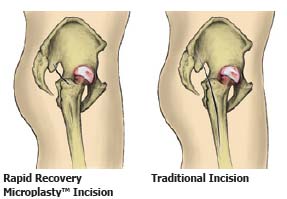Osteoarthritis and Hip Replacement
Osteoarthritis of the hip is the most common reason for a hip replacement. Osteoarthritis is caused by the wear and tear of aging. It causes the cartilage covering the joint surfaces to wear out, resulting in pain and stiffness.
Other conditions that can cause destruction of the hip joint include loss of the blood supply to the head of the thighbone (osteonecrosis), rheumatoid arthritis, injury, infection, and developmental abnormalities of the hip. Patients with arthritis may also have brittle bones (osteoporosis), but there is no direct relationship between bone density and the development of arthritis of the hip.
Symptoms of Hip Replacement
Hip arthritis typically causes pain that is dull and aching. The pain may be constant or it may come and go. Pain may be felt in the groin, thigh, and buttock, or there may be referred pain to the knee. Walking, especially for longer distances, may cause a limp.
Some patients may need a cane, crutch, or walker to help them get around. Pain usually starts slowly and worsens with time and higher activity levels.
Patients with hip arthritis may have difficulty climbing stairs. Dressing, tying shoes, and clipping toenails can be difficult or impossible. Pain may also interfere with sleep.
See your doctor to diagnose hip arthritis. The doctor will inquire about your symptoms and perform a physical examination. X-rays may show loss of the cartilage space in the hip socket and a "bone-on-bone" appearance. Bone spurs and bone cysts are common.
Sometimes, the doctor may recommend additional tests to confirm the diagnosis, including magnetic resonance imaging (MRI) or computed tomography (CT) scans.
Treatment for Osteoarthritis
Nonsurgical Treatment
For hip arthritis, the first treatment a doctor may recommend is over-the-counter, anti-inflammatory medications, such as ibuprofen. Some nutritional supplements, including glucosamine, may also provide some relief. Short-term physical therapy may help improve strength and reduce stiffness.
For patients with more advanced arthritis, use of a cane opposite the affected hip can help transfer weight away from the painful hip and improve walking ability. A walker can also be used. Arthritis, however, is progressive. Even with treatment, it will worsen over time. Weight loss can help decrease stresses on all of the joints.
Surgical Treatment
Pain and mobility may worsen with hip osteoarthritis, even when all of the recommended nonsurgical treatments have been tried. If this happens, the doctor may recommend surgery. Surgical options include :
- Arthroscopy :Arthroscopy of the hip is a minimally invasive, outpatient procedure that is relatively uncommon. The doctor may recommend it if the hip joint shows evidence of torn cartilage or loose fragments of bone or cartilage.
- Osteotomy : Candidates for osteotomy include younger patients with early arthritis, particularly those with an abnormally shallow hip socket (dysplasia). The procedure involves cutting and realigning the bones of the hip socket and/or thighbone to decrease pressure within the joint. In some people, this may delay the need for replacement surgery for 10 to 20 years.
Types of Hip Replacement
Traditional Hip Replacement
Traditional hip replacement surgery involves making a 10- to 12-inch incision on the side of the hip. The muscles are split or detached from the hip, allowing the hip to be dislocated.
Once the joint has been opened up and the joint surfaces exposed, the surgeon removes the ball at the top of the thighbone, or femur. The hip socket is prepared by removing any remaining cartilage and some of the surrounding bone. A cup-shaped implant is then pressed into the bone of the hip socket. It may be secured with screws. A smooth plastic bearing surface is then inserted into the implant so the joint can move freely.
Next, the femur is prepared. A metal stem is placed into the femur to a depth of about 6 inches. The stem implant is either fixed with bone cement or is implanted without cement. Cementless implants have a rough, porous surface. It allows bone to adhere to the implant to hold it in place. A metallic ball is then placed on the top of the stem. The ball-and-socket joint is recreated.
Minimally Invasive Hip Replacement
Minimally invasive hip replacement surgery allows the surgeon to perform the hip replacement through one or two smaller incisions.
Candidates for minimal incision procedures are typically thinner, younger, healthier, and more motivated to have a quick recovery compared with patients who undergo the traditional surgery.
Before you decide to have a minimally invasive hip replacement, get a thorough evaluation from your surgeon. Discuss with him or her the risks and benefits. Both traditional and minimally invasive hip replacement procedures are technically demanding. They require that the surgeon and operating team have considerable experience.
Technique of Minimally Invasive Total Hip Replacement
The artificial implants used for the minimally invasive hip replacement procedures are the same as those used for traditional hip replacement. Specially designed instruments are needed to prepare the socket and femur and to place the implants properly.

The surgical procedure is similar, but there is less soft-tissue dissection. A single minimally invasive hip incision may measure only 3 to 6 inches. It depends on the size of the patient and the difficulty of the procedure.
The incision is usually placed over the outside of the hip. The muscles and tendons are split or detached, but to a lesser extent than in the traditional hip replacement operation. They are routinely repaired after the surgeon places the implants. This encourages healing and helps prevent dislocation of the hip.
Two-incision hip replacement involves making a 2- to 3-inch incision over the groin for placement of the socket. A 1- to 2-inch incision is made over the buttock for placement of the stem.
To perform the two-incision procedure, the surgeon may need guidance from X-rays. It may take longer to perform this surgery than it does to perform traditional hip replacement surgery.
Benefits of Minimally Invasive Total Hip Replacement
Reported benefits of less invasive hip replacement include :
- Less pain
- More cosmetic incisions
- Less muscle damage
- Rehabilitation is faster
- Hospital stays are shorter
For traditional hip replacement, hospital stays average 4 to 5 days. Many patients need extensive rehabilitation afterward. With less-invasive procedures, the hospital stay may be as short as 1 or 2 days. Some patients can go home the day of surgery.
Early studies suggest that minimally invasive hip replacement surgery streamlines the recovery process, but the risks and long-term benefits of less-invasive techniques have not yet been documented.
Research on the Horizon
Extensive study and development are now underway to determine the long-term benefits of minimally invasive hip replacement. New technology for imaging and computer-assisted implant placement has been developed.
Surgical technique continues to be modified as experience with minimally invasive hip surgery grows. This will allow more precise reconstruction of the hip with less direct visualization. In addition, new implant designs and materials are being developed to facilitate hip surgery and prolong the lifespan of replacements.
India Surgery Minimally Invasive Hip Replacement, India Cost Minimally Invasive,Minimally Invasive Hip Replacement Surgery, Minimally Invasive Hip Replacement Surgery, India Minimally Invasive Hip Replacement Surgery, Mini Hip Replacement Surgery, Minimally Invasive Surgery, Hip Replacement Surgery, India Surgery Tour, Hip Pain Treatment, Hip Replacement, Total Hip Replacement, Mini Incision, Minimally Invasive Hip Replacement, India Hip Joint, Minimally Invasive Surgery, Hip Replacement Surgery, India Hip Replacement, India Minimally Invasive Hip, Surgery, India Minimally Invasive Hip Replacement Surgery Center





